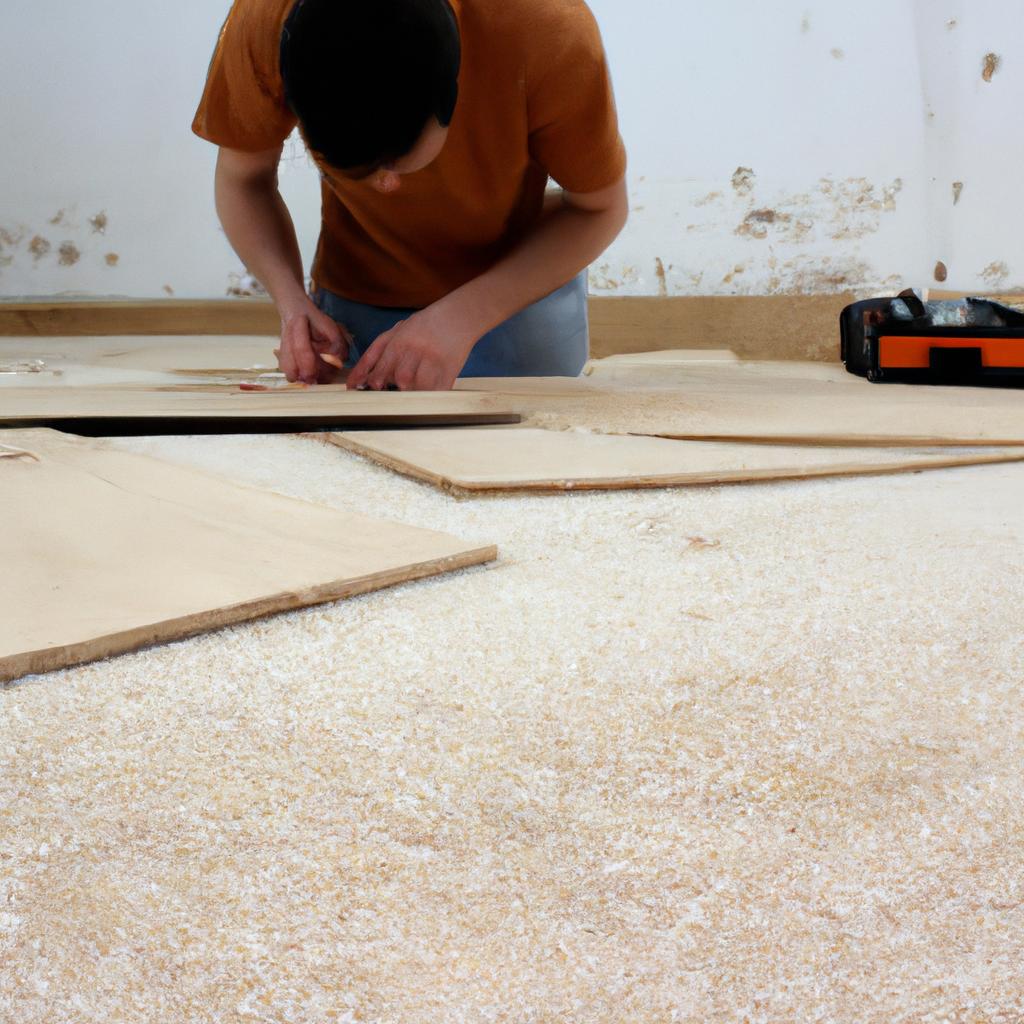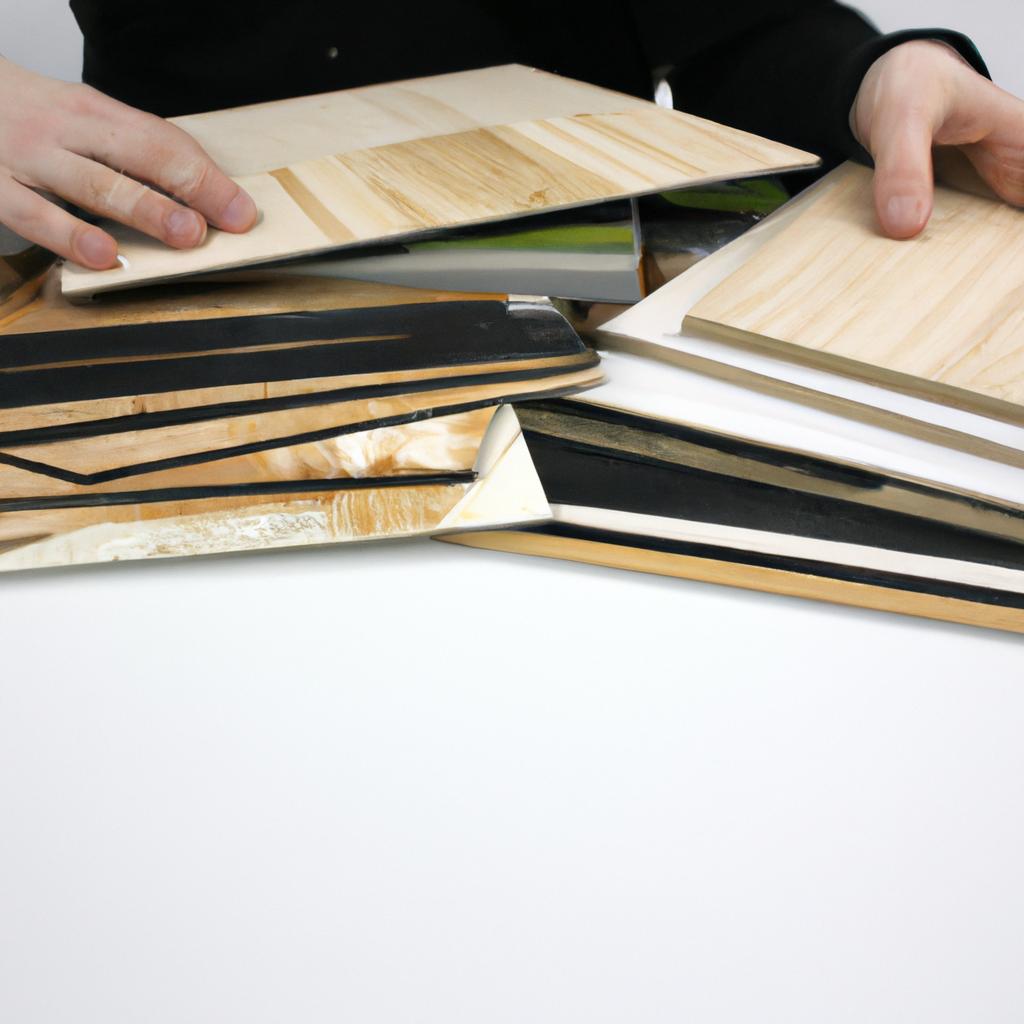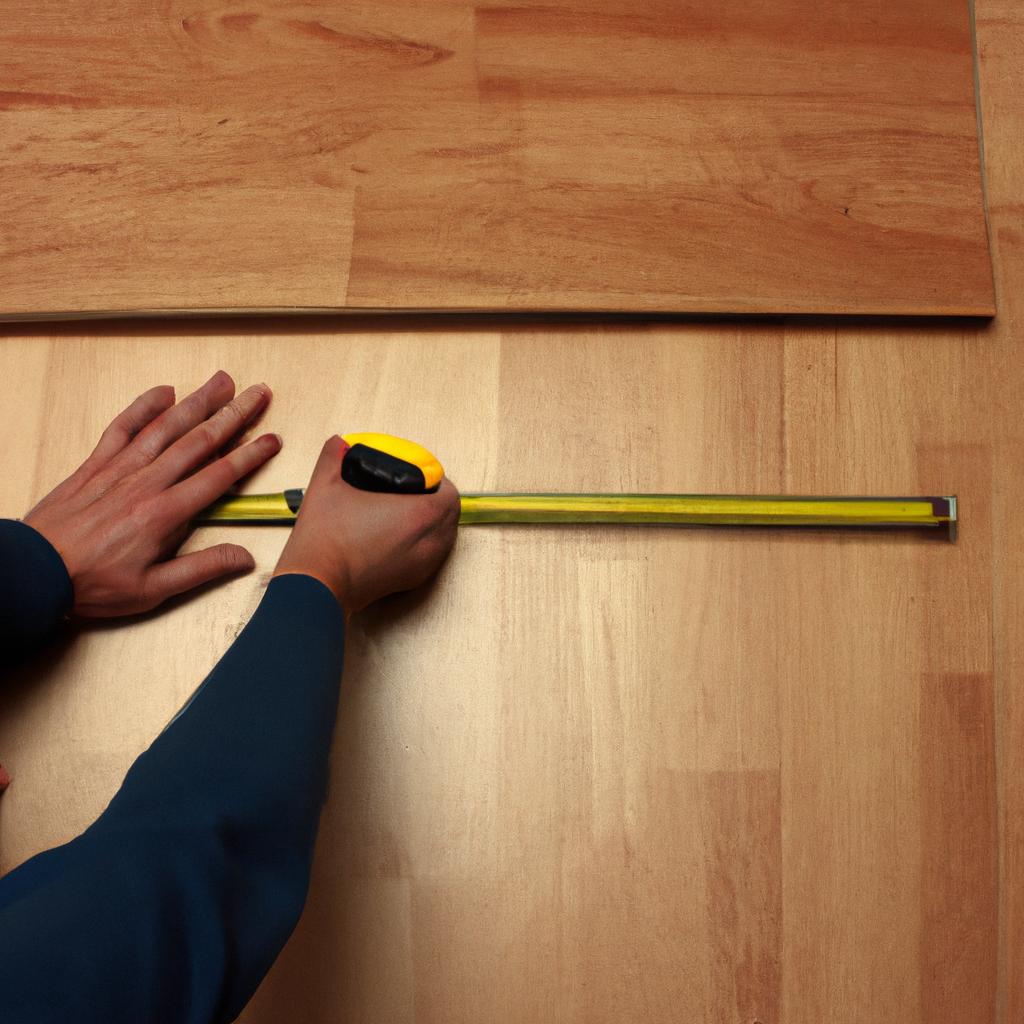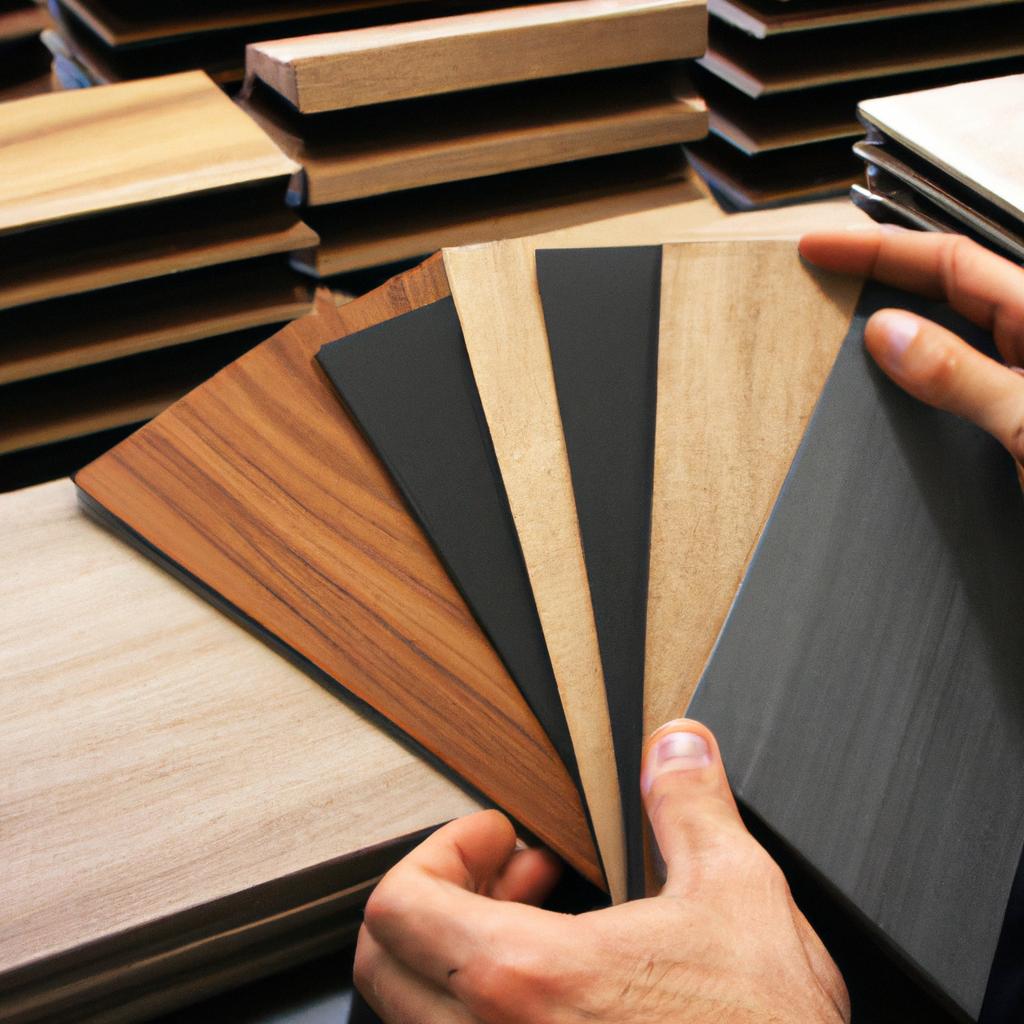Plywood is a versatile and widely used building material that finds its application in various construction projects. From flooring to roofing, plywood serves as an essential component due to its strength, durability, and cost-effectiveness. However, not all plywood is created equal; it comes in different grades that determine its quality and suitability for specific purposes. Understanding the grading system of plywood is crucial for builders and contractors alike to ensure they select the appropriate material for their projects.
In order to comprehend the significance of plywood grades, let us consider a hypothetical scenario where a homeowner plans to renovate their kitchen cabinets. They are faced with numerous options when it comes to selecting the right kind of plywood. Should they opt for A-grade plywood known for its smooth finish and minimal defects? Or should they choose C-grade plywood which provides better value but may have visible knots or patches? Making informed decisions about these choices requires an understanding of the grading system employed by lumber manufacturers. This article aims to provide a comprehensive guide on plywood grades, exploring their characteristics, applications, and implications within the realm of lumber and building materials.
Understanding Plywood Grades
Imagine you are a homeowner looking to renovate your kitchen. You head to the local home improvement store and find yourself standing in front of a wide array of plywood options, each labeled with various grades. Confused about which one to choose, you start wondering what these grades mean and how they will impact your project. This is where understanding plywood grades becomes crucial.
Plywood grading involves assessing the quality and appearance of the wood panels based on specific criteria set by industry standards. These grades provide valuable information about the structural integrity and aesthetic appeal of the plywood, helping consumers make informed decisions. In short, knowing plywood grades can save you from potential headaches down the line.
To grasp this concept better, let’s delve into some key points:
-
Grades determine strength: Each grade signifies different levels of strength and durability for particular applications. For example, if you’re building cabinets or furniture that requires sturdiness, opting for a higher-grade plywood would be prudent. On the other hand, lower-grade plywood may suffice for less demanding tasks like temporary structures or non-structural uses.
-
Appearance matters: Plywood grades also assess the visual characteristics of the wood panel surface. Knots, patches, discoloration, and other imperfections affect its overall look. Higher-grade plywood tends to have fewer blemishes and more consistent color variations, making it ideal for projects that prioritize aesthetics.
-
Cost considerations: As expected, there is usually a correlation between grade and cost—the higher the grade, the more expensive the plywood tends to be due to superior quality and appearance factors mentioned earlier.
-
Application suitability: Understanding plywood grades helps match them with specific project requirements effectively. Whether it’s construction purposes such as flooring or roofing or decorative elements like wall paneling or shelving—choosing an appropriate grade ensures optimum performance.
Now let’s take a closer look at how different plywood grades compare:
| Grade | Description | Typical Use |
|---|---|---|
| A | Smooth, knot-free surface with minimal imperfections | Cabinetry, fine furniture |
| B | Some minor blemishes and knots; suitable for painting | General construction, shelving |
| C | More noticeable defects but still structurally sound | Roofing, subflooring |
| D | Contains visible flaws and knots; best concealed | Temporary structures, packaging materials |
Understanding the nuances of plywood grading empowers consumers to make informed choices based on their specific needs. By considering factors such as strength requirements, aesthetic preferences, cost limitations, and intended application, you can select the right grade that aligns with your project goals.
Moving forward into our discussion on “The Importance of Quality Lumber,” we will explore how choosing high-grade plywood is just one aspect of ensuring a successful construction or renovation endeavor.
The Importance of Quality Lumber
Understanding Plywood Grades
In the previous section, we explored the concept of plywood grades and their significance in determining the quality of lumber used in construction projects. Now, let us delve further into why it is crucial to prioritize high-quality lumber for your building needs.
Imagine this scenario: you are constructing a new deck for your backyard. You have chosen an affordable plywood grade with lower structural integrity, thinking that it would suffice for your project’s requirements. However, as time passes and exposure to the elements takes its toll, you start noticing cracks forming on the surface and warping occurring despite minimal stress. This situation illustrates how opting for subpar plywood can lead to long-term consequences and compromise the overall durability of your structure.
To understand why quality lumber matters, consider these factors:
- Structural Stability: High-grade plywood offers superior stability due to its enhanced strength properties. It ensures that your constructed surfaces remain intact even under heavy loads or adverse weather conditions.
- Enhanced Aesthetics: Quality lumber often exhibits better visual appeal compared to lower-grade alternatives. Smoothness, uniformity, and absence of defects contribute to a visually pleasing finished product.
- Longevity: Choosing top-notch plywood increases the lifespan of your structures by minimizing issues like warping, delamination, or rotting caused by moisture ingress or physical stress.
- Safety Assurance: Opting for higher-grade materials provides assurance that your constructions meet safety standards and can withstand potential hazards effectively.
Consider the following comparison table showcasing key differences between low-grade and high-grade plywood:
| Property | Low-Grade Plywood | High-Grade Plywood |
|---|---|---|
| Strength | Lower | Higher |
| Surface Uniformity | Inconsistent | Consistent |
| Durability | Shorter Lifespan | Longer Lifespan |
| Appearance | More Defects | Fewer Defects |
As you can see, choosing quality lumber is crucial in ensuring long-lasting and aesthetically pleasing structures. Understanding these different types will further aid you in making informed decisions for your construction projects.
Transitioning into the subsequent section about “Different Types of Plywood,” let us now examine the diverse range of options available that cater to varying needs and preferences.
Different Types of Plywood
Plywood Grades: A Guide to Lumber and Building Materials
The Importance of Quality Lumber has been emphasized in the previous section, as it plays a crucial role in ensuring the integrity and longevity of any construction project. Now, let us delve into understanding the Different Types of Plywood available in the market today.
Imagine you are embarking on a home renovation project and need to choose plywood for constructing new cabinets. As you visit your local lumberyard, you come across various options with different grades, each offering specific characteristics and functionalities. To make an informed decision, it is essential to understand the distinctions between these plywood types.
To begin with, here are four key factors that differentiate plywood grades:
- Veneer quality: This refers to the outermost layer of wood used to construct plywood sheets. Higher-grade plywood typically features high-quality veneers without any visible defects such as knots or patches.
- Core material: The core material determines the strength and stability of plywood. While some varieties use solid wood cores, others incorporate composite materials like particleboard or medium-density fiberboard (MDF).
- Thickness: Plywood comes in various thicknesses, ranging from 1/8 inch to over 1 inch. Thicker plywood offers increased durability but may not be necessary for every application.
- Formaldehyde emissions: Some plywood products adhere to strict environmental standards by using low-emission adhesives that minimize harmful chemical off-gassing.
To better illustrate these differences, consider the following table comparing three common grades of plywood:
| Grade | Veneer Quality | Core Material | Thickness Range |
|---|---|---|---|
| A | High-quality | Solid wood | Typically 1/4″ – 3/4″ |
| B | Few minor defects | Composite (particle board/MDF) | Typically 1/4″ – 1/2″ |
| C | Visible defects | Composite (particle board/MDF) | Typically 3/8″ – 3/4″ |
As you can see, Grade A plywood offers the best veneer quality and solid wood core, making it suitable for visible applications where aesthetics are important. On the other hand, Grade C plywood may have more visible defects but is often used in less conspicuous areas or as a base layer beneath higher-grade finishes.
In summary, understanding the different types of plywood grades enables homeowners and builders to choose materials that align with their specific requirements. In the subsequent section about Factors to Consider When Choosing Plywood, we will explore additional aspects such as cost-effectiveness, moisture resistance, and structural properties. By considering these factors comprehensively, one can make an informed decision when selecting plywood for any construction project.
Factors to Consider When Choosing Plywood
Plywood Grades: A Guide to Lumber and Building Materials
Different Types of Plywood
In the previous section, we explored the different types of plywood available in the market. Now, let’s delve into some important factors that should be considered when choosing plywood for your specific project.
Factors to Consider When Choosing Plywood
To illustrate these considerations, let’s imagine a scenario where you are building a bookshelf. The first factor to take into account is the intended use of the furniture piece. If it will bear heavy loads or endure frequent movement, selecting a higher-grade plywood with enhanced strength and durability becomes crucial. For our bookshelf example, a cabinet grade plywood would be suitable due to its superior strength and stability.
Additionally, consider the aesthetic appeal desired for your project. Different grades of plywood can have varying appearances, ranging from smooth and uniform surfaces to those with visible knots and imperfections. Depending on your preferences and design goals, you may opt for a high-quality veneer-faced plywood or choose one with character-enhancing features like rustic grains or natural blemishes.
When evaluating various options, keep in mind other practical aspects such as cost-efficiency and availability. While marine-grade plywood offers excellent moisture resistance properties which might seem ideal for outdoor projects such as garden furniture, it tends to be more expensive compared to standard exterior-grade alternatives. Moreover, certain specialty plywoods may only be accessible through specialized suppliers or manufacturers.
Considering all these factors allows you to make an informed decision about which type of plywood best suits your needs while balancing performance requirements against budget constraints.
- Achieve peace of mind by investing in durable and reliable materials.
- Build furniture pieces that reflect your personal style and taste.
- Enhance the longevity of your creations by selecting appropriate grades of plywood.
- Enjoy greater flexibility in design choices based on available options.
Emotional Response Table:
| Grade | Strength | Appearance | Moisture Resistance |
|---|---|---|---|
| Cabinet | High | Smooth, uniform | Moderate |
| Exterior | Medium | Varies | Good |
| Marine | Very high | Varies | Excellent |
| Specialty | Depends | Depends | Varies |
Common Applications for Various Plywood Grades
By understanding these practical uses, you can further refine your decision-making process and ensure that your chosen plywood grade aligns perfectly with your project requirements.
(Note: The subsequent section about “Common Applications for Various Plywood Grades” will provide more detailed information on this topic.)
Common Applications for Various Plywood Grades
In the previous section, we discussed the importance of understanding different factors when selecting plywood for your construction projects. Now, let’s delve deeper into these considerations and explore how they can impact your decision-making process.
One crucial factor to consider is the intended application of the plywood. For example, if you are constructing furniture that requires a smooth finish, you would opt for a higher grade plywood such as A or B. On the other hand, if you’re working on an outdoor project like building a shed, Marine-grade plywood would be more suitable due to its exceptional resistance to moisture and rot.
Additionally, it’s essential to take into account the expected load-bearing capacity of the plywood. If you’re constructing shelves or cabinets that will hold heavy items, choosing a thicker plywood with higher overall strength is advisable. Conversely, for lighter applications like decorative paneling or temporary structures, thinner plywoods may suffice.
Furthermore, considering cost-effectiveness plays a significant role in decision-making. While high-grade plywoods offer superior quality and durability, they also come at a higher price point. Therefore, striking a balance between budget constraints and desired performance becomes vital.
To further emphasize these considerations:
- Durability: Ensure the chosen grade of plywood offers sufficient durability for your specific project.
- Appearance: Select plywood grades that align with aesthetic requirements.
- Sustainability: Opt for eco-friendly options whenever possible.
- Local availability: Assess whether preferred grades are readily accessible in your area.
The table below provides an overview comparing various common plywood grades based on their characteristics:
| Grade | Description | Common Applications |
|---|---|---|
| A | Highest-quality face veneer | Furniture making |
| B | Solid surface appearance | Cabinetry |
| C | Suitable for paint finishes | Interior walls |
| D | Rough surface | Temporary formwork or sheds |
Considering these factors and understanding the characteristics of different plywood grades will enable you to make informed decisions when it comes to selecting the most suitable material for your project.
Transitioning into our next section, let’s now explore some essential tips for proper plywood maintenance. By following these guidelines, you can ensure the longevity and performance of your chosen plywood materials without compromising structural integrity.
Tips for Proper Plywood Maintenance
Transitioning smoothly from the previous section, let us now delve into essential tips for maintaining plywood in optimal condition. To illustrate the importance of proper maintenance practices, consider a hypothetical scenario where plywood is installed as flooring material in a residential kitchen. Over time, without regular upkeep, spills and moisture exposure can cause the plywood to swell, warp, or even develop mold growth. By following these maintenance guidelines, you can ensure the longevity and durability of your plywood installations.
Firstly, it is crucial to clean any spills on plywood surfaces promptly. Failure to do so may result in irreversible damage. For instance, if water seeps into exposed edges or cracks on exterior-grade plywood used for outdoor structures like decks or fences, it can lead to rotting over time. Taking immediate action by wiping away spilled liquids with a dry cloth or mop will help prevent such issues.
Secondly, periodic inspections are vital to identify potential problems early on. Regularly check plywood surfaces for signs of wear and tear such as scratches or surface damage. In high-traffic areas like commercial spaces or hallways within homes, protective measures like rugs or mats can be employed to reduce direct contact with heavy objects that could dent or scratch the plywood surface.
Thirdly, applying appropriate finishes and sealants can significantly enhance the durability and appearance of plywood. Depending on its intended use—whether indoors or outdoors—a suitable finish should be selected accordingly. Applying paint, varnish, or stains not only protects against external elements but also adds aesthetic value to the wood grain.
To further emphasize the significance of proper maintenance practices, consider the emotional impact of neglecting routine care:
- Increased expenses: Neglecting maintenance leads to costly repairs due to severe damages.
- Frustration and inconvenience: Dealing with deteriorated plywood can disrupt daily activities and cause frustration.
- Diminished aesthetic appeal: Poorly maintained plywood diminishes the visual appeal of any space, impacting one’s overall satisfaction.
- Health hazards: Mold growth resulting from moisture damage poses health risks to occupants.
| Maintenance Tips for Plywood |
|---|
| Clean spills promptly |
Incorporating these maintenance practices into your regular routine will ensure that your plywood installations remain in excellent condition. By taking proactive measures, you not only avoid potential issues but also extend the lifespan of your plywood materials.
Note: It is important to remember that while these guidelines provide general advice on proper maintenance, consulting specific manufacturer recommendations is always recommended for optimal care.
 Bergmann Lumber
Bergmann Lumber



